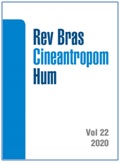Body segments and biological maturation to estimate the propulsive force of the arm in young swimmers
DOI:
https://doi.org/10.1590/1980-0037.2020v22e74881Abstract
This study aimed to estimate the propulsive force of the arm (PFA) in young freestyle swimmers and propose an equation to estimate propulsive force, considering anthropometric variables and maturity offset. Seventy-six competitive swimmers [boys: n= 53; age= 13.58 ± 1.79; girls: n= 23; age= 12.98 ± 1.79] participated in this study. Height, lean mass, sitting height, leg length, arm span, triceps skinfold, arm muscle area (AMA), and maturity offset were assessed. The propulsive force of the arm was measured by the tethered swim test. A multiple linear regression (concurrent model) was used to develop the equation using the variables AMA, arm span, and maturity offset. The Bland–Altman method was used to compare the values found between PFA and propulsive force–estimated (PFE). There was a significant correlation between the variables PFA and AMA (R²=0.12; p<0.01), arm span (R²=0.21; p<0.01), and maturity offset (R²=0.20; p<0.01) for boys, whilst in girls theses values were: AMA (R²=0.07;p=0.20), arm span (R²=0.50;p<0.01), and maturity offset (R²=0.44;p<0.01). Two linear equations were established to predict the PFA in boys and girls Bland-Altman analysis showed an agreement between PFA and PFE. In conclusion, the equation is a valuable tool to monitor training and help improve swimmer performance.
References
Barbosa TM, Morais JE, Marques MC, Costa MJ, Marinho DA. The Power Output and Sprinting Performance of Young Swimmers. J Strength Cond Res 2015;29(2):440–50.
Crowley E, Harrison AJ, Lyons M. The Impact of Resistance Training on Swimming Performance: A Systematic Review. Sport Med 2017;47(11):2285–307.
Toussaint HM, Roos PE, Kolmogorov S. The determination of drag in front crawl swimming. J Biomech 2004;37(11):1655–63.
Muniz-Pardos B, Gomez-Bruton A, Matute-llorente A, Gonzalez-Aguero A, Gomez-Cabello A, Gonzalo-Skok O, et al. Nonspecific Resistance Training and Swimming Performance : Strength or Power ? A Systematic Review. J Strength Cond Res in press
Cochrane KC, Housh TJ, Smith CM, Hill EC, Jenkins NDM, Johnson GO, et al. Relative Contributions of Strength, Anthropometric, and Body Composition Characteristics to Estimated Propulsive Force in Young Male Swimmers. J Strength Cond Res 2015;29(6):1473–9.
Nevill AM, Negra Y, Myers TD, Sammoud S, Nevill AM. Key somatic variables associated with , and differences between the 4 swimming strokes strokes. J Sports Sci 2020;38(7):787–94.
Nevill AM, Oxford SW, Duncan MJ. Optimal Body Size and Limb Length Ratios Associated with 100-m Personal-Best Swim Speeds. Med Sci Sport Exerc 2015;47(8):1714–8.
Santos MAM, Barbosa Junior ML, Melo WVDC, Costa AV, Costa MDC. Estimate of propulsive force in front crawl swimming in young athletes. Open Access J Sport Med 2012;3(1):115–20.
Morouço PG, Marinho DA, Izquierdo M, Neiva H, Marques MC. Relative Contribution of Arms and Legs in 30 s Fully Tethered Front Crawl Swimming. Biomed Res Int 2015;2015: 563206.
Morais JE, Saavedra JM, Costa MJ, Silva AJ, Marinho DA, Barbosa TM. Tracking young talented swimmers: Follow-up of performance and its biomechanical determinant factors. Acta Bioeng Biomech 2013;15(3):129–38.



